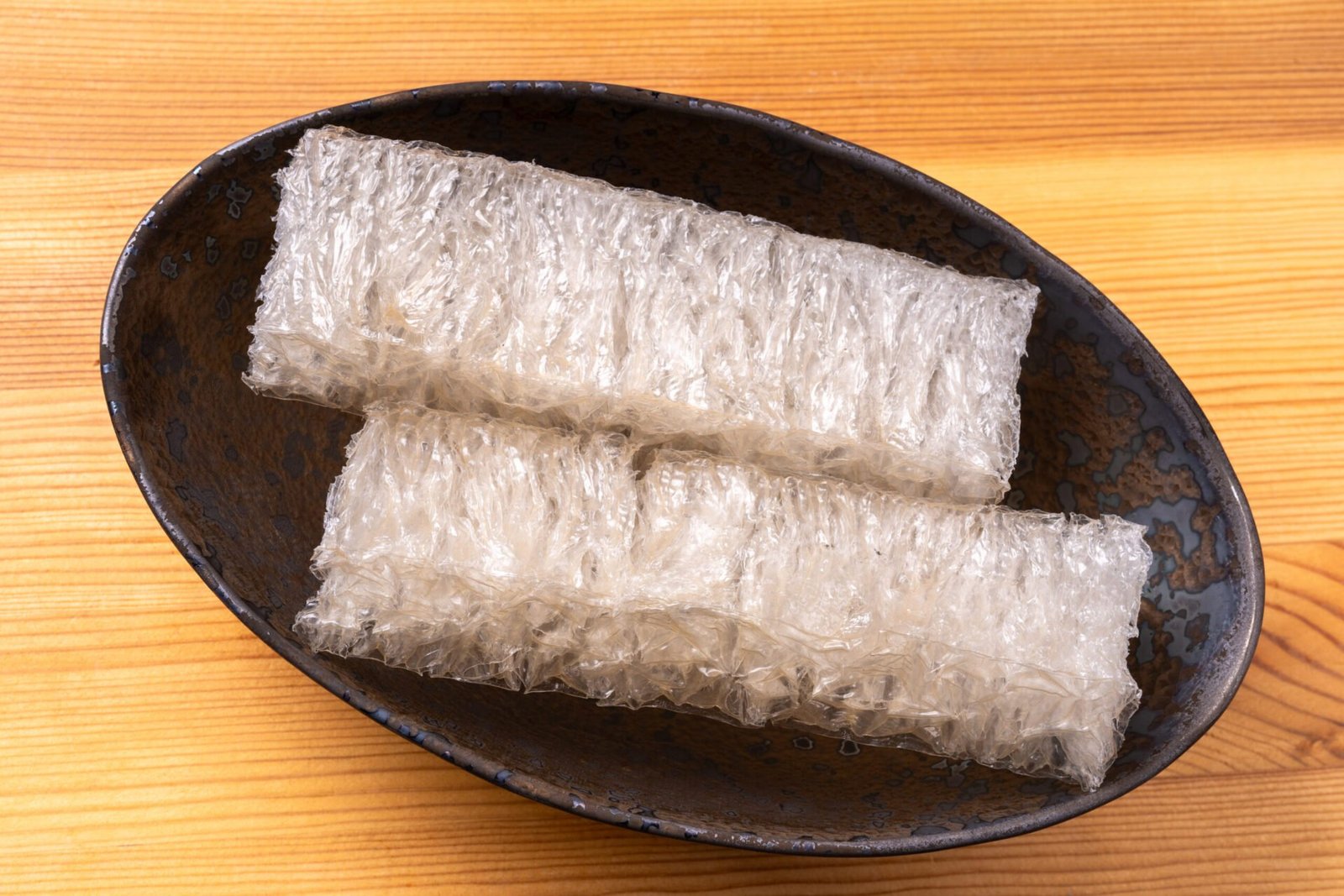Japan’s Superfood used for Wagashi Changes World
The world of Japanese sweets (wagashi) hides ingredients that are not only delicious but also beneficial for health. Among these, “kanten” (agar) stands out. While kanten has long been a staple in Japanese cuisine, it’s now emerging as a superfood perfectly aligned with modern health trends. Let’s delve into the fascinating world of kanten, Japan’s hidden superfood.
What is Kanten: Japan’s Plant-Based Gelatin
Kanten is a food product made from seaweed, primarily tengusa (red algae). It’s created by boiling seaweed, then cooling and drying the resulting liquid. Kanten comes in various forms, including translucent bars and powder, which turn into a jelly-like substance when reconstituted with water. While similar to Western gelatin, kanten is entirely plant-based, making it a healthier alternative.

The History of Kanten: From Accidental Discovery to Wagashi Staple
The discovery of kanten dates back to the early Edo period. Legend has it that an innkeeper in Kyoto discarded leftover tengusa broth outside, only to find it frozen and dried the next day. This accidental discovery led to kanten becoming deeply rooted in Japanese food culture, especially in the world of wagashi, giving birth to classic sweets like yokan and mizu-manju.
Kanten’s Nutritional Value: Low in Calories, High in Fiber
Kanten’s most remarkable feature is its impressive nutritional profile. It’s virtually calorie-free, containing only 3 calories per 100 grams. More notably, kanten is incredibly rich in dietary fiber. Its main component is insoluble fiber, with about 80 grams of fiber per 100 grams of kanten. This is several times more than most fruits and vegetables.
Health Benefits of Kanten: From Diet Aid to Digestive Health
The potential health benefits of kanten are numerous. Its high fiber content may help improve constipation and promote overall digestive health. The fiber in kanten can also serve as food for beneficial gut bacteria, potentially improving the intestinal environment.
Kanten is also gaining attention for its potential diet effects. It absorbs water and expands in the stomach, potentially promoting a feeling of fullness and helping prevent overeating. Some studies suggest it may help slow the rapid rise in blood sugar after meals, making it of interest from a diabetes prevention perspective.
However, it’s important to note that these health effects may vary between individuals and depend on the amount and method of consumption. Kanten should be incorporated as part of a balanced diet rather than relied upon as a miracle food.
Kanten in Wagashi: Fusion of Tradition and Innovation
Kanten is widely used in the world of wagashi, with its properties utilized to create various sweets. Here are some representative wagashi that use kanten:
- Yokan: Perhaps the most famous kanten-based wagashi. This sweet bean jelly is enjoyed chilled in summer and at room temperature in winter.
- Mizu-manju: A summer staple where sweet bean paste is wrapped in translucent kanten jelly.
- Kanten jelly: Modern wagashi often flavored with fruit or matcha, popular as a low-calorie, healthy dessert.
- Kingyoku-kan: A beautiful layered kanten dessert known for its colorful appearance and refreshing taste.
- Kanten-yose: A cool summer wagashi where seasonal fruits or vegetables are set in kanten jelly.
These wagashi cleverly utilize kanten’s properties. Its gelling power helps maintain shape, while its texture gives wagashi a unique mouthfeel. Moreover, kanten’s neutral flavor allows it to enhance other ingredients’ tastes.
Kanten as a Superfood: Addressing Modern Health Challenges
In modern society, the increase in obesity and lifestyle-related diseases has become a major health concern. Kanten, with its unique properties, has the potential to address these issues.
Low in calories and rich in fiber, kanten is ideal for those needing to restrict calorie intake or increase their fiber consumption. Its potential to slow carbohydrate absorption may also benefit those managing blood sugar levels.
Furthermore, kanten’s ability to promote satiety makes it beneficial for those looking to reduce snacking or control portion sizes. It offers a natural approach to the “overeating” problem many modern individuals face.
Kanten vs. Other Superfoods: Comparative Advantages
In recent years, various superfoods like chia seeds and acai berries have gained attention. How does kanten compare?
In terms of fiber content, kanten overwhelms other superfoods. While chia seeds contain about 34 grams of fiber per 100 grams, kanten contains more than twice that amount.
Kanten also has an advantage in terms of calories. Acai berries contain about 70 calories per 100 grams, while kanten has merely 3 calories.
Moreover, kanten is a traditional Japanese ingredient with a long history of consumption, making it a trusted food in terms of safety.
Price-wise, kanten is relatively inexpensive and easily accessible compared to imported superfoods, making it easier to incorporate into daily diets.
Global Recognition of Kanten: Japan’s Traditional Ingredient Gains Attention
Kanten is gaining attention overseas, particularly among vegans and vegetarians as a plant-based alternative to animal gelatin. Healthy recipes in Western countries now often feature kanten-based desserts and drinks.
Beyond food, kanten’s applications are expanding. In biotechnology, it’s used for microbial cultivation. The cosmetics industry is developing products containing kanten extract.
Thus, while rooted in Japanese tradition, kanten is poised to meet modern global demands. Its applications are expected to expand further across various fields in the future.
Conclusion: Japan’s Natural Superfood to be Proud Of
Kanten, while long familiar to Japanese people, is a superior superfood that aligns with modern health trends. Its low-calorie, high-fiber properties have the potential to address contemporary health challenges.
Moreover, kanten is safe and easily accessible, making it a convenient superfood to incorporate into daily meals.
The appeal of kanten seems to have depths yet to be fully explored. It’s certainly a natural superfood from Japan worth keeping an eye on in the future.
